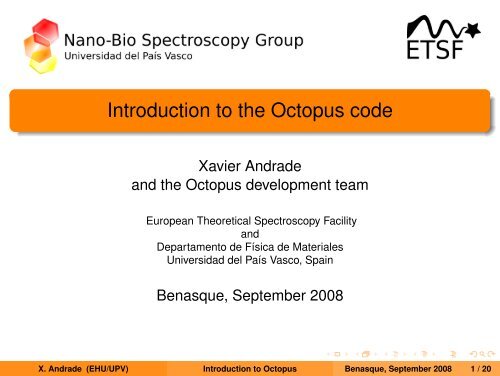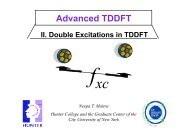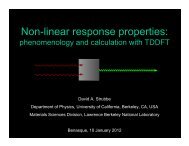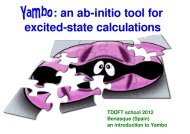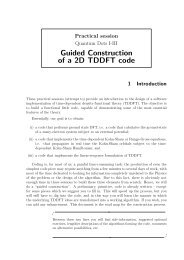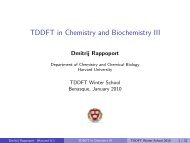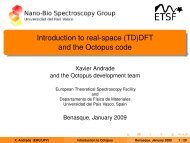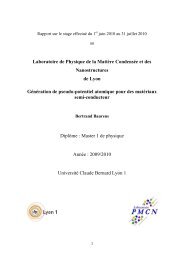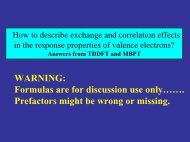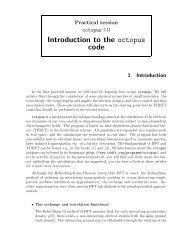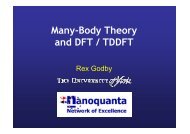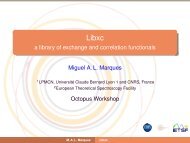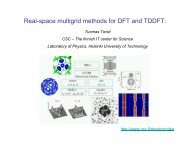Introduction to the Octopus code - TDDFT.org
Introduction to the Octopus code - TDDFT.org
Introduction to the Octopus code - TDDFT.org
You also want an ePaper? Increase the reach of your titles
YUMPU automatically turns print PDFs into web optimized ePapers that Google loves.
<strong>Introduction</strong> <strong>to</strong> <strong>the</strong> Oc<strong>to</strong>pus <strong>code</strong><br />
Xavier Andrade<br />
and <strong>the</strong> Oc<strong>to</strong>pus development team<br />
European Theoretical Spectroscopy Facility<br />
and<br />
Departamen<strong>to</strong> de Física de Materiales<br />
Universidad del País Vasco, Spain<br />
Benasque, September 2008<br />
X. Andrade (EHU/UPV) <strong>Introduction</strong> <strong>to</strong> Oc<strong>to</strong>pus Benasque, September 2008 1 / 20
The Oc<strong>to</strong>pus<br />
Oc<strong>to</strong>puses are cephalopods from <strong>the</strong> oc<strong>to</strong>poda order.<br />
They live in <strong>the</strong> sea (also in trees).<br />
From few cm <strong>to</strong> 20 m.<br />
Very smart animals.<br />
Well equipped:<br />
Poison<br />
Ink<br />
Camouflage.<br />
Release <strong>the</strong>ir tentacles.<br />
Very effective hunters:<br />
<strong>the</strong>y eat crabs, fishes, mussels, siestas, etc.<br />
X. Andrade (EHU/UPV) <strong>Introduction</strong> <strong>to</strong> Oc<strong>to</strong>pus Benasque, September 2008 2 / 20
Oc<strong>to</strong>pus 1<br />
Fortran 95 and C.<br />
Focused on finite systems (periodic systems not mature yet).<br />
Norm-conserving pseudo-potentials.<br />
Real space grid representation.<br />
Features:<br />
Ground state DFT.<br />
<strong>TDDFT</strong><br />
Time propagation:<br />
Linear response and strong fields.<br />
Ehrenfest molecular dynamics.<br />
Casida LR-<strong>TDDFT</strong>.<br />
Sternheimer linear response.<br />
Optimal control <strong>the</strong>ory.<br />
Real-time quantum transport.<br />
1 http://www.tddft.<strong>org</strong>/programs/oc<strong>to</strong>pus<br />
X. Andrade (EHU/UPV) <strong>Introduction</strong> <strong>to</strong> Oc<strong>to</strong>pus Benasque, September 2008 3 / 20
Oc<strong>to</strong>pus 1<br />
Fortran 95 and C.<br />
Focused on finite systems (periodic systems not mature yet).<br />
Norm-conserving pseudo-potentials.<br />
Real space grid representation.<br />
Features:<br />
Ground state DFT.<br />
<strong>TDDFT</strong><br />
Time propagation:<br />
Linear response and strong fields.<br />
Ehrenfest molecular dynamics.<br />
Casida LR-<strong>TDDFT</strong>.<br />
Sternheimer linear response.<br />
Optimal control <strong>the</strong>ory.<br />
Real-time quantum transport.<br />
1 http://www.tddft.<strong>org</strong>/programs/oc<strong>to</strong>pus<br />
X. Andrade (EHU/UPV) <strong>Introduction</strong> <strong>to</strong> Oc<strong>to</strong>pus Benasque, September 2008 3 / 20
Oc<strong>to</strong>pus 1<br />
Fortran 95 and C.<br />
Focused on finite systems (periodic systems not mature yet).<br />
Norm-conserving pseudo-potentials.<br />
Real space grid representation.<br />
Features:<br />
Ground state DFT.<br />
<strong>TDDFT</strong><br />
Time propagation:<br />
Linear response and strong fields.<br />
Ehrenfest molecular dynamics.<br />
Casida LR-<strong>TDDFT</strong>.<br />
Sternheimer linear response.<br />
Optimal control <strong>the</strong>ory.<br />
Real-time quantum transport.<br />
1 http://www.tddft.<strong>org</strong>/programs/oc<strong>to</strong>pus<br />
X. Andrade (EHU/UPV) <strong>Introduction</strong> <strong>to</strong> Oc<strong>to</strong>pus Benasque, September 2008 3 / 20
Oc<strong>to</strong>pus 1<br />
Fortran 95 and C.<br />
Focused on finite systems (periodic systems not mature yet).<br />
Norm-conserving pseudo-potentials.<br />
Real space grid representation.<br />
Features:<br />
Ground state DFT.<br />
<strong>TDDFT</strong><br />
Time propagation:<br />
Linear response and strong fields.<br />
Ehrenfest molecular dynamics.<br />
Casida LR-<strong>TDDFT</strong>.<br />
Sternheimer linear response.<br />
Optimal control <strong>the</strong>ory.<br />
Real-time quantum transport.<br />
1 http://www.tddft.<strong>org</strong>/programs/oc<strong>to</strong>pus<br />
X. Andrade (EHU/UPV) <strong>Introduction</strong> <strong>to</strong> Oc<strong>to</strong>pus Benasque, September 2008 3 / 20
Oc<strong>to</strong>pus 1<br />
Fortran 95 and C.<br />
Focused on finite systems (periodic systems not mature yet).<br />
Norm-conserving pseudo-potentials.<br />
Real space grid representation.<br />
Features:<br />
Ground state DFT.<br />
<strong>TDDFT</strong><br />
Time propagation:<br />
Linear response and strong fields.<br />
Ehrenfest molecular dynamics.<br />
Casida LR-<strong>TDDFT</strong>.<br />
Sternheimer linear response.<br />
Optimal control <strong>the</strong>ory.<br />
Real-time quantum transport.<br />
1 http://www.tddft.<strong>org</strong>/programs/oc<strong>to</strong>pus<br />
X. Andrade (EHU/UPV) <strong>Introduction</strong> <strong>to</strong> Oc<strong>to</strong>pus Benasque, September 2008 3 / 20
Oc<strong>to</strong>pus 1<br />
Fortran 95 and C.<br />
Focused on finite systems (periodic systems not mature yet).<br />
Norm-conserving pseudo-potentials.<br />
Real space grid representation.<br />
Features:<br />
Ground state DFT.<br />
<strong>TDDFT</strong><br />
Time propagation:<br />
Linear response and strong fields.<br />
Ehrenfest molecular dynamics.<br />
Casida LR-<strong>TDDFT</strong>.<br />
Sternheimer linear response.<br />
Optimal control <strong>the</strong>ory.<br />
Real-time quantum transport.<br />
1 http://www.tddft.<strong>org</strong>/programs/oc<strong>to</strong>pus<br />
X. Andrade (EHU/UPV) <strong>Introduction</strong> <strong>to</strong> Oc<strong>to</strong>pus Benasque, September 2008 3 / 20
Oc<strong>to</strong>pus 1<br />
Fortran 95 and C.<br />
Focused on finite systems (periodic systems not mature yet).<br />
Norm-conserving pseudo-potentials.<br />
Real space grid representation.<br />
Features:<br />
Ground state DFT.<br />
<strong>TDDFT</strong><br />
Time propagation:<br />
Linear response and strong fields.<br />
Ehrenfest molecular dynamics.<br />
Casida LR-<strong>TDDFT</strong>.<br />
Sternheimer linear response.<br />
Optimal control <strong>the</strong>ory.<br />
Real-time quantum transport.<br />
1 http://www.tddft.<strong>org</strong>/programs/oc<strong>to</strong>pus<br />
X. Andrade (EHU/UPV) <strong>Introduction</strong> <strong>to</strong> Oc<strong>to</strong>pus Benasque, September 2008 3 / 20
Oc<strong>to</strong>pus 1<br />
Fortran 95 and C.<br />
Focused on finite systems (periodic systems not mature yet).<br />
Norm-conserving pseudo-potentials.<br />
Real space grid representation.<br />
Features:<br />
Ground state DFT.<br />
<strong>TDDFT</strong><br />
Time propagation:<br />
Linear response and strong fields.<br />
Ehrenfest molecular dynamics.<br />
Casida LR-<strong>TDDFT</strong>.<br />
Sternheimer linear response.<br />
Optimal control <strong>the</strong>ory.<br />
Real-time quantum transport.<br />
1 http://www.tddft.<strong>org</strong>/programs/oc<strong>to</strong>pus<br />
X. Andrade (EHU/UPV) <strong>Introduction</strong> <strong>to</strong> Oc<strong>to</strong>pus Benasque, September 2008 3 / 20
Oc<strong>to</strong>pus 1<br />
Fortran 95 and C.<br />
Focused on finite systems (periodic systems not mature yet).<br />
Norm-conserving pseudo-potentials.<br />
Real space grid representation.<br />
Features:<br />
Ground state DFT.<br />
<strong>TDDFT</strong><br />
Time propagation:<br />
Linear response and strong fields.<br />
Ehrenfest molecular dynamics.<br />
Casida LR-<strong>TDDFT</strong>.<br />
Sternheimer linear response.<br />
Optimal control <strong>the</strong>ory.<br />
Real-time quantum transport.<br />
1 http://www.tddft.<strong>org</strong>/programs/oc<strong>to</strong>pus<br />
X. Andrade (EHU/UPV) <strong>Introduction</strong> <strong>to</strong> Oc<strong>to</strong>pus Benasque, September 2008 3 / 20
Oc<strong>to</strong>pus 1<br />
Fortran 95 and C.<br />
Focused on finite systems (periodic systems not mature yet).<br />
Norm-conserving pseudo-potentials.<br />
Real space grid representation.<br />
Features:<br />
Ground state DFT.<br />
<strong>TDDFT</strong><br />
Time propagation:<br />
Linear response and strong fields.<br />
Ehrenfest molecular dynamics.<br />
Casida LR-<strong>TDDFT</strong>.<br />
Sternheimer linear response.<br />
Optimal control <strong>the</strong>ory.<br />
Real-time quantum transport.<br />
1 http://www.tddft.<strong>org</strong>/programs/oc<strong>to</strong>pus<br />
X. Andrade (EHU/UPV) <strong>Introduction</strong> <strong>to</strong> Oc<strong>to</strong>pus Benasque, September 2008 3 / 20
Oc<strong>to</strong>pus 1<br />
Fortran 95 and C.<br />
Focused on finite systems (periodic systems not mature yet).<br />
Norm-conserving pseudo-potentials.<br />
Real space grid representation.<br />
Features:<br />
Ground state DFT.<br />
<strong>TDDFT</strong><br />
Time propagation:<br />
Linear response and strong fields.<br />
Ehrenfest molecular dynamics.<br />
Casida LR-<strong>TDDFT</strong>.<br />
Sternheimer linear response.<br />
Optimal control <strong>the</strong>ory.<br />
Real-time quantum transport.<br />
1 http://www.tddft.<strong>org</strong>/programs/oc<strong>to</strong>pus<br />
X. Andrade (EHU/UPV) <strong>Introduction</strong> <strong>to</strong> Oc<strong>to</strong>pus Benasque, September 2008 3 / 20
Oc<strong>to</strong>pus 1<br />
Fortran 95 and C.<br />
Focused on finite systems (periodic systems not mature yet).<br />
Norm-conserving pseudo-potentials.<br />
Real space grid representation.<br />
Features:<br />
Ground state DFT.<br />
<strong>TDDFT</strong><br />
Time propagation:<br />
Linear response and strong fields.<br />
Ehrenfest molecular dynamics.<br />
Casida LR-<strong>TDDFT</strong>.<br />
Sternheimer linear response.<br />
Optimal control <strong>the</strong>ory.<br />
Real-time quantum transport.<br />
1 http://www.tddft.<strong>org</strong>/programs/oc<strong>to</strong>pus<br />
X. Andrade (EHU/UPV) <strong>Introduction</strong> <strong>to</strong> Oc<strong>to</strong>pus Benasque, September 2008 3 / 20
Oc<strong>to</strong>pus 1<br />
Fortran 95 and C.<br />
Focused on finite systems (periodic systems not mature yet).<br />
Norm-conserving pseudo-potentials.<br />
Real space grid representation.<br />
Features:<br />
Ground state DFT.<br />
<strong>TDDFT</strong><br />
Time propagation:<br />
Linear response and strong fields.<br />
Ehrenfest molecular dynamics.<br />
Casida LR-<strong>TDDFT</strong>.<br />
Sternheimer linear response.<br />
Optimal control <strong>the</strong>ory.<br />
Real-time quantum transport.<br />
1 http://www.tddft.<strong>org</strong>/programs/oc<strong>to</strong>pus<br />
X. Andrade (EHU/UPV) <strong>Introduction</strong> <strong>to</strong> Oc<strong>to</strong>pus Benasque, September 2008 3 / 20
Oc<strong>to</strong>pus 1<br />
Fortran 95 and C.<br />
Focused on finite systems (periodic systems not mature yet).<br />
Norm-conserving pseudo-potentials.<br />
Real space grid representation.<br />
Features:<br />
Ground state DFT.<br />
<strong>TDDFT</strong><br />
Time propagation:<br />
Linear response and strong fields.<br />
Ehrenfest molecular dynamics.<br />
Casida LR-<strong>TDDFT</strong>.<br />
Sternheimer linear response.<br />
Optimal control <strong>the</strong>ory.<br />
Real-time quantum transport.<br />
1 http://www.tddft.<strong>org</strong>/programs/oc<strong>to</strong>pus<br />
X. Andrade (EHU/UPV) <strong>Introduction</strong> <strong>to</strong> Oc<strong>to</strong>pus Benasque, September 2008 3 / 20
Pseudo-potentials<br />
The a<strong>to</strong>mic potential is very strong.<br />
Lots of core electrons.<br />
Core electrons are independent<br />
of <strong>the</strong> environment.<br />
Replace <strong>the</strong> potential and core electrons<br />
by a pseudo-potential.<br />
Norm-conserving pseudo-potentials<br />
V = Vloc + <br />
|lm〉 (Vl − Vloc) 〈lm|<br />
lm<br />
X. Andrade (EHU/UPV) <strong>Introduction</strong> <strong>to</strong> Oc<strong>to</strong>pus Benasque, September 2008 4 / 20
Pseudo-potentials<br />
The a<strong>to</strong>mic potential is very strong.<br />
Lots of core electrons.<br />
Core electrons are independent<br />
of <strong>the</strong> environment.<br />
Replace <strong>the</strong> potential and core electrons<br />
by a pseudo-potential.<br />
Norm-conserving pseudo-potentials<br />
V = Vloc + <br />
|lm〉 (Vl − Vloc) 〈lm|<br />
lm<br />
X. Andrade (EHU/UPV) <strong>Introduction</strong> <strong>to</strong> Oc<strong>to</strong>pus Benasque, September 2008 4 / 20
Pseudo-potentials<br />
The a<strong>to</strong>mic potential is very strong.<br />
Lots of core electrons.<br />
Core electrons are independent<br />
of <strong>the</strong> environment.<br />
Replace <strong>the</strong> potential and core electrons<br />
by a pseudo-potential.<br />
Norm-conserving pseudo-potentials<br />
V = Vloc + <br />
|lm〉 (Vl − Vloc) 〈lm|<br />
lm<br />
X. Andrade (EHU/UPV) <strong>Introduction</strong> <strong>to</strong> Oc<strong>to</strong>pus Benasque, September 2008 4 / 20
Pseudo-potentials<br />
The a<strong>to</strong>mic potential is very strong.<br />
Lots of core electrons.<br />
Core electrons are independent<br />
of <strong>the</strong> environment.<br />
Replace <strong>the</strong> potential and core electrons<br />
by a pseudo-potential.<br />
Norm-conserving pseudo-potentials<br />
V = Vloc + <br />
|lm〉 (Vl − Vloc) 〈lm|<br />
lm<br />
X. Andrade (EHU/UPV) <strong>Introduction</strong> <strong>to</strong> Oc<strong>to</strong>pus Benasque, September 2008 4 / 20
Pseudo-potentials<br />
The a<strong>to</strong>mic potential is very strong.<br />
Lots of core electrons.<br />
Core electrons are independent<br />
of <strong>the</strong> environment.<br />
Replace <strong>the</strong> potential and core electrons<br />
by a pseudo-potential.<br />
Norm-conserving pseudo-potentials<br />
V = Vloc + <br />
|lm〉 (Vl − Vloc) 〈lm|<br />
lm<br />
X. Andrade (EHU/UPV) <strong>Introduction</strong> <strong>to</strong> Oc<strong>to</strong>pus Benasque, September 2008 4 / 20
Real space grid<br />
Partial Differential Equation: infinite degrees of freedom.<br />
Reduce it <strong>to</strong> a finite number.<br />
Functions are represented by its value over a set of points.<br />
Point distribution:<br />
Uniform space grid.<br />
Distance between points is constant: Spacing.<br />
Non-uniform grids.<br />
Finite region of <strong>the</strong> space: Box<br />
X. Andrade (EHU/UPV) <strong>Introduction</strong> <strong>to</strong> Oc<strong>to</strong>pus Benasque, September 2008 5 / 20
Real space grid<br />
Partial Differential Equation: infinite degrees of freedom.<br />
Reduce it <strong>to</strong> a finite number.<br />
Functions are represented by its value over a set of points.<br />
Point distribution:<br />
Uniform space grid.<br />
Distance between points is constant: Spacing.<br />
Non-uniform grids.<br />
Finite region of <strong>the</strong> space: Box<br />
X. Andrade (EHU/UPV) <strong>Introduction</strong> <strong>to</strong> Oc<strong>to</strong>pus Benasque, September 2008 5 / 20
Real space grid<br />
Partial Differential Equation: infinite degrees of freedom.<br />
Reduce it <strong>to</strong> a finite number.<br />
Functions are represented by its value over a set of points.<br />
Point distribution:<br />
Uniform space grid.<br />
Distance between points is constant: Spacing.<br />
Non-uniform grids.<br />
Finite region of <strong>the</strong> space: Box<br />
X. Andrade (EHU/UPV) <strong>Introduction</strong> <strong>to</strong> Oc<strong>to</strong>pus Benasque, September 2008 5 / 20
Real space grid<br />
Partial Differential Equation: infinite degrees of freedom.<br />
Reduce it <strong>to</strong> a finite number.<br />
Functions are represented by its value over a set of points.<br />
Point distribution:<br />
Uniform space grid.<br />
Distance between points is constant: Spacing.<br />
Non-uniform grids.<br />
Finite region of <strong>the</strong> space: Box<br />
X. Andrade (EHU/UPV) <strong>Introduction</strong> <strong>to</strong> Oc<strong>to</strong>pus Benasque, September 2008 5 / 20
Real space grid<br />
Partial Differential Equation: infinite degrees of freedom.<br />
Reduce it <strong>to</strong> a finite number.<br />
Functions are represented by its value over a set of points.<br />
Point distribution:<br />
Uniform space grid.<br />
Distance between points is constant: Spacing.<br />
Non-uniform grids.<br />
Finite region of <strong>the</strong> space: Box<br />
X. Andrade (EHU/UPV) <strong>Introduction</strong> <strong>to</strong> Oc<strong>to</strong>pus Benasque, September 2008 5 / 20
Real space grid<br />
Partial Differential Equation: infinite degrees of freedom.<br />
Reduce it <strong>to</strong> a finite number.<br />
Functions are represented by its value over a set of points.<br />
Point distribution:<br />
Uniform space grid.<br />
Distance between points is constant: Spacing.<br />
Non-uniform grids.<br />
Finite region of <strong>the</strong> space: Box<br />
X. Andrade (EHU/UPV) <strong>Introduction</strong> <strong>to</strong> Oc<strong>to</strong>pus Benasque, September 2008 5 / 20
Real space grid<br />
Partial Differential Equation: infinite degrees of freedom.<br />
Reduce it <strong>to</strong> a finite number.<br />
Functions are represented by its value over a set of points.<br />
Point distribution:<br />
Uniform space grid.<br />
Distance between points is constant: Spacing.<br />
Non-uniform grids.<br />
Finite region of <strong>the</strong> space: Box<br />
X. Andrade (EHU/UPV) <strong>Introduction</strong> <strong>to</strong> Oc<strong>to</strong>pus Benasque, September 2008 5 / 20
Real space grid<br />
Partial Differential Equation: infinite degrees of freedom.<br />
Reduce it <strong>to</strong> a finite number.<br />
Functions are represented by its value over a set of points.<br />
Point distribution:<br />
Uniform space grid.<br />
Distance between points is constant: Spacing.<br />
Non-uniform grids.<br />
Finite region of <strong>the</strong> space: Box<br />
X. Andrade (EHU/UPV) <strong>Introduction</strong> <strong>to</strong> Oc<strong>to</strong>pus Benasque, September 2008 5 / 20
Real space grid: 2D Example<br />
X. Andrade (EHU/UPV) <strong>Introduction</strong> <strong>to</strong> Oc<strong>to</strong>pus Benasque, September 2008 6 / 20
Boundary conditions<br />
For finite systems functions go <strong>to</strong> zero.<br />
Impose functions <strong>to</strong> be zero over <strong>the</strong> border of <strong>the</strong> box.<br />
The box has <strong>to</strong> be large enough <strong>to</strong> contain <strong>the</strong> functions.<br />
O<strong>the</strong>r BCs are possible: periodic, zero derivative, open.<br />
X. Andrade (EHU/UPV) <strong>Introduction</strong> <strong>to</strong> Oc<strong>to</strong>pus Benasque, September 2008 7 / 20
Boundary conditions<br />
For finite systems functions go <strong>to</strong> zero.<br />
Impose functions <strong>to</strong> be zero over <strong>the</strong> border of <strong>the</strong> box.<br />
The box has <strong>to</strong> be large enough <strong>to</strong> contain <strong>the</strong> functions.<br />
O<strong>the</strong>r BCs are possible: periodic, zero derivative, open.<br />
X. Andrade (EHU/UPV) <strong>Introduction</strong> <strong>to</strong> Oc<strong>to</strong>pus Benasque, September 2008 7 / 20
Boundary conditions<br />
For finite systems functions go <strong>to</strong> zero.<br />
Impose functions <strong>to</strong> be zero over <strong>the</strong> border of <strong>the</strong> box.<br />
The box has <strong>to</strong> be large enough <strong>to</strong> contain <strong>the</strong> functions.<br />
O<strong>the</strong>r BCs are possible: periodic, zero derivative, open.<br />
X. Andrade (EHU/UPV) <strong>Introduction</strong> <strong>to</strong> Oc<strong>to</strong>pus Benasque, September 2008 7 / 20
Boundary conditions<br />
For finite systems functions go <strong>to</strong> zero.<br />
Impose functions <strong>to</strong> be zero over <strong>the</strong> border of <strong>the</strong> box.<br />
The box has <strong>to</strong> be large enough <strong>to</strong> contain <strong>the</strong> functions.<br />
O<strong>the</strong>r BCs are possible: periodic, zero derivative, open.<br />
X. Andrade (EHU/UPV) <strong>Introduction</strong> <strong>to</strong> Oc<strong>to</strong>pus Benasque, September 2008 7 / 20
Boundary conditions<br />
Optimize <strong>the</strong> shape of <strong>the</strong> box <strong>to</strong> minimize <strong>the</strong> number of points.<br />
General box shape:<br />
Minimum box: a sphere around each a<strong>to</strong>m.<br />
Sphere.<br />
Cylinder.<br />
Parallelepiped.<br />
Arbitrary.<br />
X. Andrade (EHU/UPV) <strong>Introduction</strong> <strong>to</strong> Oc<strong>to</strong>pus Benasque, September 2008 8 / 20
Boundary conditions<br />
Optimize <strong>the</strong> shape of <strong>the</strong> box <strong>to</strong> minimize <strong>the</strong> number of points.<br />
General box shape:<br />
Minimum box: a sphere around each a<strong>to</strong>m.<br />
Sphere.<br />
Cylinder.<br />
Parallelepiped.<br />
Arbitrary.<br />
X. Andrade (EHU/UPV) <strong>Introduction</strong> <strong>to</strong> Oc<strong>to</strong>pus Benasque, September 2008 8 / 20
Boundary conditions<br />
Optimize <strong>the</strong> shape of <strong>the</strong> box <strong>to</strong> minimize <strong>the</strong> number of points.<br />
General box shape:<br />
Minimum box: a sphere around each a<strong>to</strong>m.<br />
Sphere.<br />
Cylinder.<br />
Parallelepiped.<br />
Arbitrary.<br />
X. Andrade (EHU/UPV) <strong>Introduction</strong> <strong>to</strong> Oc<strong>to</strong>pus Benasque, September 2008 8 / 20
Boundary conditions<br />
Optimize <strong>the</strong> shape of <strong>the</strong> box <strong>to</strong> minimize <strong>the</strong> number of points.<br />
General box shape:<br />
Minimum box: a sphere around each a<strong>to</strong>m.<br />
Sphere.<br />
Cylinder.<br />
Parallelepiped.<br />
Arbitrary.<br />
X. Andrade (EHU/UPV) <strong>Introduction</strong> <strong>to</strong> Oc<strong>to</strong>pus Benasque, September 2008 8 / 20
Boundary conditions<br />
Optimize <strong>the</strong> shape of <strong>the</strong> box <strong>to</strong> minimize <strong>the</strong> number of points.<br />
General box shape:<br />
Minimum box: a sphere around each a<strong>to</strong>m.<br />
Sphere.<br />
Cylinder.<br />
Parallelepiped.<br />
Arbitrary.<br />
X. Andrade (EHU/UPV) <strong>Introduction</strong> <strong>to</strong> Oc<strong>to</strong>pus Benasque, September 2008 8 / 20
Boundary conditions<br />
Optimize <strong>the</strong> shape of <strong>the</strong> box <strong>to</strong> minimize <strong>the</strong> number of points.<br />
General box shape:<br />
Minimum box: a sphere around each a<strong>to</strong>m.<br />
Sphere.<br />
Cylinder.<br />
Parallelepiped.<br />
Arbitrary.<br />
X. Andrade (EHU/UPV) <strong>Introduction</strong> <strong>to</strong> Oc<strong>to</strong>pus Benasque, September 2008 8 / 20
Boundary conditions<br />
Optimize <strong>the</strong> shape of <strong>the</strong> box <strong>to</strong> minimize <strong>the</strong> number of points.<br />
General box shape:<br />
Minimum box: a sphere around each a<strong>to</strong>m.<br />
Sphere.<br />
Cylinder.<br />
Parallelepiped.<br />
Arbitrary.<br />
X. Andrade (EHU/UPV) <strong>Introduction</strong> <strong>to</strong> Oc<strong>to</strong>pus Benasque, September 2008 8 / 20
Real space grid characteristics<br />
Natural boundary conditions for different problems.<br />
Systematically improve discretisation quality:<br />
Decrease <strong>the</strong> spacing.<br />
Increase <strong>the</strong> box size.<br />
Orthogonal “basis set”.<br />
Independent of a<strong>to</strong>mic positions (no Pulay forces).<br />
Problems:<br />
Breaking of translational invariance: egg-box effect.<br />
Breaking of rotational invariance.<br />
X. Andrade (EHU/UPV) <strong>Introduction</strong> <strong>to</strong> Oc<strong>to</strong>pus Benasque, September 2008 9 / 20
Real space grid characteristics<br />
Natural boundary conditions for different problems.<br />
Systematically improve discretisation quality:<br />
Decrease <strong>the</strong> spacing.<br />
Increase <strong>the</strong> box size.<br />
Orthogonal “basis set”.<br />
Independent of a<strong>to</strong>mic positions (no Pulay forces).<br />
Problems:<br />
Breaking of translational invariance: egg-box effect.<br />
Breaking of rotational invariance.<br />
X. Andrade (EHU/UPV) <strong>Introduction</strong> <strong>to</strong> Oc<strong>to</strong>pus Benasque, September 2008 9 / 20
Real space grid characteristics<br />
Natural boundary conditions for different problems.<br />
Systematically improve discretisation quality:<br />
Decrease <strong>the</strong> spacing.<br />
Increase <strong>the</strong> box size.<br />
Orthogonal “basis set”.<br />
Independent of a<strong>to</strong>mic positions (no Pulay forces).<br />
Problems:<br />
Breaking of translational invariance: egg-box effect.<br />
Breaking of rotational invariance.<br />
X. Andrade (EHU/UPV) <strong>Introduction</strong> <strong>to</strong> Oc<strong>to</strong>pus Benasque, September 2008 9 / 20
Real space grid characteristics<br />
Natural boundary conditions for different problems.<br />
Systematically improve discretisation quality:<br />
Decrease <strong>the</strong> spacing.<br />
Increase <strong>the</strong> box size.<br />
Orthogonal “basis set”.<br />
Independent of a<strong>to</strong>mic positions (no Pulay forces).<br />
Problems:<br />
Breaking of translational invariance: egg-box effect.<br />
Breaking of rotational invariance.<br />
X. Andrade (EHU/UPV) <strong>Introduction</strong> <strong>to</strong> Oc<strong>to</strong>pus Benasque, September 2008 9 / 20
Real space grid characteristics<br />
Natural boundary conditions for different problems.<br />
Systematically improve discretisation quality:<br />
Decrease <strong>the</strong> spacing.<br />
Increase <strong>the</strong> box size.<br />
Orthogonal “basis set”.<br />
Independent of a<strong>to</strong>mic positions (no Pulay forces).<br />
Problems:<br />
Breaking of translational invariance: egg-box effect.<br />
Breaking of rotational invariance.<br />
X. Andrade (EHU/UPV) <strong>Introduction</strong> <strong>to</strong> Oc<strong>to</strong>pus Benasque, September 2008 9 / 20
Real space grid characteristics<br />
Natural boundary conditions for different problems.<br />
Systematically improve discretisation quality:<br />
Decrease <strong>the</strong> spacing.<br />
Increase <strong>the</strong> box size.<br />
Orthogonal “basis set”.<br />
Independent of a<strong>to</strong>mic positions (no Pulay forces).<br />
Problems:<br />
Breaking of translational invariance: egg-box effect.<br />
Breaking of rotational invariance.<br />
X. Andrade (EHU/UPV) <strong>Introduction</strong> <strong>to</strong> Oc<strong>to</strong>pus Benasque, September 2008 9 / 20
Real space grid characteristics<br />
Natural boundary conditions for different problems.<br />
Systematically improve discretisation quality:<br />
Decrease <strong>the</strong> spacing.<br />
Increase <strong>the</strong> box size.<br />
Orthogonal “basis set”.<br />
Independent of a<strong>to</strong>mic positions (no Pulay forces).<br />
Problems:<br />
Breaking of translational invariance: egg-box effect.<br />
Breaking of rotational invariance.<br />
X. Andrade (EHU/UPV) <strong>Introduction</strong> <strong>to</strong> Oc<strong>to</strong>pus Benasque, September 2008 9 / 20
Real space grid characteristics<br />
Natural boundary conditions for different problems.<br />
Systematically improve discretisation quality:<br />
Decrease <strong>the</strong> spacing.<br />
Increase <strong>the</strong> box size.<br />
Orthogonal “basis set”.<br />
Independent of a<strong>to</strong>mic positions (no Pulay forces).<br />
Problems:<br />
Breaking of translational invariance: egg-box effect.<br />
Breaking of rotational invariance.<br />
X. Andrade (EHU/UPV) <strong>Introduction</strong> <strong>to</strong> Oc<strong>to</strong>pus Benasque, September 2008 9 / 20
Real space grid characteristics<br />
Natural boundary conditions for different problems.<br />
Systematically improve discretisation quality:<br />
Decrease <strong>the</strong> spacing.<br />
Increase <strong>the</strong> box size.<br />
Orthogonal “basis set”.<br />
Independent of a<strong>to</strong>mic positions (no Pulay forces).<br />
Problems:<br />
Breaking of translational invariance: egg-box effect.<br />
Breaking of rotational invariance.<br />
X. Andrade (EHU/UPV) <strong>Introduction</strong> <strong>to</strong> Oc<strong>to</strong>pus Benasque, September 2008 9 / 20
Differential operations<br />
Finite difference approach<br />
∇ 2 n<br />
f(nxh, nyh) =<br />
i<br />
n<br />
Derivative in a point:<br />
sum over neighbour points.<br />
cij depend on <strong>the</strong> points used:<br />
<strong>the</strong> stencil.<br />
More points → more precision.<br />
Semi-local operation.<br />
j<br />
cij<br />
h f(nxh + ih, nyh + jh)<br />
X. Andrade (EHU/UPV) <strong>Introduction</strong> <strong>to</strong> Oc<strong>to</strong>pus Benasque, September 2008 10 / 20
Differential operations<br />
Finite difference approach<br />
∇ 2 n<br />
f(nxh, nyh) =<br />
i<br />
n<br />
Derivative in a point:<br />
sum over neighbour points.<br />
cij depend on <strong>the</strong> points used:<br />
<strong>the</strong> stencil.<br />
More points → more precision.<br />
Semi-local operation.<br />
j<br />
cij<br />
h f(nxh + ih, nyh + jh)<br />
X. Andrade (EHU/UPV) <strong>Introduction</strong> <strong>to</strong> Oc<strong>to</strong>pus Benasque, September 2008 10 / 20
Differential operations<br />
Finite difference approach<br />
∇ 2 n<br />
f(nxh, nyh) =<br />
i<br />
n<br />
Derivative in a point:<br />
sum over neighbour points.<br />
cij depend on <strong>the</strong> points used:<br />
<strong>the</strong> stencil.<br />
More points → more precision.<br />
Semi-local operation.<br />
j<br />
cij<br />
h f(nxh + ih, nyh + jh)<br />
X. Andrade (EHU/UPV) <strong>Introduction</strong> <strong>to</strong> Oc<strong>to</strong>pus Benasque, September 2008 10 / 20
Differential operations<br />
Finite difference approach<br />
∇ 2 n<br />
f(nxh, nyh) =<br />
i<br />
n<br />
Derivative in a point:<br />
sum over neighbour points.<br />
cij depend on <strong>the</strong> points used:<br />
<strong>the</strong> stencil.<br />
More points → more precision.<br />
Semi-local operation.<br />
j<br />
cij<br />
h f(nxh + ih, nyh + jh)<br />
X. Andrade (EHU/UPV) <strong>Introduction</strong> <strong>to</strong> Oc<strong>to</strong>pus Benasque, September 2008 10 / 20
Integration<br />
Trapezoidal rule <br />
Sum over grid points.<br />
<br />
2<br />
f(x, y) dx dy = h<br />
ij<br />
f(ih, jh)<br />
X. Andrade (EHU/UPV) <strong>Introduction</strong> <strong>to</strong> Oc<strong>to</strong>pus Benasque, September 2008 11 / 20
Integration<br />
Trapezoidal rule <br />
Sum over grid points.<br />
<br />
2<br />
f(x, y) dx dy = h<br />
ij<br />
f(ih, jh)<br />
X. Andrade (EHU/UPV) <strong>Introduction</strong> <strong>to</strong> Oc<strong>to</strong>pus Benasque, September 2008 11 / 20
Ground state calculations<br />
What we want <strong>to</strong> solve:<br />
Kohn-Sham equations<br />
−∇ 2 φk + Veff [ρ] (r)φk = ɛkφk<br />
We use a self-consistency scheme <strong>to</strong> treat non-linearity.<br />
X. Andrade (EHU/UPV) <strong>Introduction</strong> <strong>to</strong> Oc<strong>to</strong>pus Benasque, September 2008 12 / 20
Ground state calculations<br />
What we want <strong>to</strong> solve:<br />
Kohn-Sham equations<br />
−∇ 2 φk + Veff [ρ] (r)φk = ɛkφk<br />
We use a self-consistency scheme <strong>to</strong> treat non-linearity.<br />
X. Andrade (EHU/UPV) <strong>Introduction</strong> <strong>to</strong> Oc<strong>to</strong>pus Benasque, September 2008 12 / 20
Ground state calculations<br />
What we want <strong>to</strong> solve:<br />
Kohn-Sham equations<br />
−∇ 2 φk + Veff [ρ] (r)φk = ɛkφk<br />
We use a self-consistency scheme <strong>to</strong> treat non-linearity.<br />
X. Andrade (EHU/UPV) <strong>Introduction</strong> <strong>to</strong> Oc<strong>to</strong>pus Benasque, September 2008 12 / 20
Discretisation of <strong>the</strong> Hamil<strong>to</strong>nian<br />
For <strong>the</strong> laplacian we use finite differences<br />
High order schemes are needed.<br />
The local part of <strong>the</strong> potential is direct.<br />
The non-local potential is applied in small spherical grid around<br />
<strong>the</strong> a<strong>to</strong>ms.<br />
The Hamil<strong>to</strong>nian becomes a finite size matrix.<br />
X. Andrade (EHU/UPV) <strong>Introduction</strong> <strong>to</strong> Oc<strong>to</strong>pus Benasque, September 2008 13 / 20
Discretisation of <strong>the</strong> Hamil<strong>to</strong>nian<br />
For <strong>the</strong> laplacian we use finite differences<br />
High order schemes are needed.<br />
The local part of <strong>the</strong> potential is direct.<br />
The non-local potential is applied in small spherical grid around<br />
<strong>the</strong> a<strong>to</strong>ms.<br />
The Hamil<strong>to</strong>nian becomes a finite size matrix.<br />
X. Andrade (EHU/UPV) <strong>Introduction</strong> <strong>to</strong> Oc<strong>to</strong>pus Benasque, September 2008 13 / 20
Discretisation of <strong>the</strong> Hamil<strong>to</strong>nian<br />
For <strong>the</strong> laplacian we use finite differences<br />
High order schemes are needed.<br />
The local part of <strong>the</strong> potential is direct.<br />
The non-local potential is applied in small spherical grid around<br />
<strong>the</strong> a<strong>to</strong>ms.<br />
The Hamil<strong>to</strong>nian becomes a finite size matrix.<br />
X. Andrade (EHU/UPV) <strong>Introduction</strong> <strong>to</strong> Oc<strong>to</strong>pus Benasque, September 2008 13 / 20
Discretisation of <strong>the</strong> Hamil<strong>to</strong>nian<br />
For <strong>the</strong> laplacian we use finite differences<br />
High order schemes are needed.<br />
The local part of <strong>the</strong> potential is direct.<br />
The non-local potential is applied in small spherical grid around<br />
<strong>the</strong> a<strong>to</strong>ms.<br />
The Hamil<strong>to</strong>nian becomes a finite size matrix.<br />
X. Andrade (EHU/UPV) <strong>Introduction</strong> <strong>to</strong> Oc<strong>to</strong>pus Benasque, September 2008 13 / 20
Discretisation of <strong>the</strong> Hamil<strong>to</strong>nian<br />
For <strong>the</strong> laplacian we use finite differences<br />
High order schemes are needed.<br />
The local part of <strong>the</strong> potential is direct.<br />
The non-local potential is applied in small spherical grid around<br />
<strong>the</strong> a<strong>to</strong>ms.<br />
The Hamil<strong>to</strong>nian becomes a finite size matrix.<br />
X. Andrade (EHU/UPV) <strong>Introduction</strong> <strong>to</strong> Oc<strong>to</strong>pus Benasque, September 2008 13 / 20
The eigenproblem<br />
Find <strong>the</strong> eigenvec<strong>to</strong>rs and eigenvalues of a matrix.<br />
Very large matrix with lots of zero components (Sparse).<br />
Iterative solvers where only <strong>the</strong> action of <strong>the</strong> matrix is required.<br />
X. Andrade (EHU/UPV) <strong>Introduction</strong> <strong>to</strong> Oc<strong>to</strong>pus Benasque, September 2008 14 / 20
The eigenproblem<br />
Find <strong>the</strong> eigenvec<strong>to</strong>rs and eigenvalues of a matrix.<br />
Very large matrix with lots of zero components (Sparse).<br />
Iterative solvers where only <strong>the</strong> action of <strong>the</strong> matrix is required.<br />
X. Andrade (EHU/UPV) <strong>Introduction</strong> <strong>to</strong> Oc<strong>to</strong>pus Benasque, September 2008 14 / 20
The eigenproblem<br />
Find <strong>the</strong> eigenvec<strong>to</strong>rs and eigenvalues of a matrix.<br />
Very large matrix with lots of zero components (Sparse).<br />
Iterative solvers where only <strong>the</strong> action of <strong>the</strong> matrix is required.<br />
X. Andrade (EHU/UPV) <strong>Introduction</strong> <strong>to</strong> Oc<strong>to</strong>pus Benasque, September 2008 14 / 20
The eigensolver<br />
We minimize (using conjugated gradient or o<strong>the</strong>r method):<br />
Rayleigh-Ritz quotient<br />
Works for <strong>the</strong> first state.<br />
ɛ(ψ) = 〈ψ|H|ψ〉<br />
〈ψ|ψ〉<br />
For higher energy states it is necessary <strong>to</strong> orthogonalize against<br />
<strong>the</strong> lower ones.<br />
X. Andrade (EHU/UPV) <strong>Introduction</strong> <strong>to</strong> Oc<strong>to</strong>pus Benasque, September 2008 15 / 20
The eigensolver<br />
We minimize (using conjugated gradient or o<strong>the</strong>r method):<br />
Rayleigh-Ritz quotient<br />
Works for <strong>the</strong> first state.<br />
ɛ(ψ) = 〈ψ|H|ψ〉<br />
〈ψ|ψ〉<br />
For higher energy states it is necessary <strong>to</strong> orthogonalize against<br />
<strong>the</strong> lower ones.<br />
X. Andrade (EHU/UPV) <strong>Introduction</strong> <strong>to</strong> Oc<strong>to</strong>pus Benasque, September 2008 15 / 20
The eigensolver<br />
We minimize (using conjugated gradient or o<strong>the</strong>r method):<br />
Rayleigh-Ritz quotient<br />
Works for <strong>the</strong> first state.<br />
ɛ(ψ) = 〈ψ|H|ψ〉<br />
〈ψ|ψ〉<br />
For higher energy states it is necessary <strong>to</strong> orthogonalize against<br />
<strong>the</strong> lower ones.<br />
X. Andrade (EHU/UPV) <strong>Introduction</strong> <strong>to</strong> Oc<strong>to</strong>pus Benasque, September 2008 15 / 20
The eigensolver<br />
We minimize (using conjugated gradient or o<strong>the</strong>r method):<br />
Rayleigh-Ritz quotient<br />
Works for <strong>the</strong> first state.<br />
ɛ(ψ) = 〈ψ|H|ψ〉<br />
〈ψ|ψ〉<br />
For higher energy states it is necessary <strong>to</strong> orthogonalize against<br />
<strong>the</strong> lower ones.<br />
X. Andrade (EHU/UPV) <strong>Introduction</strong> <strong>to</strong> Oc<strong>to</strong>pus Benasque, September 2008 15 / 20
Time propagation<br />
Main feature of Oc<strong>to</strong>pus.<br />
Given an initial condition, solve <strong>the</strong>:<br />
Time-dependent Kohn-Sham equation<br />
i ∂φk<br />
∂t = −∇2 φk + Veff [ρ] (r, t)φk<br />
Many properties can be obtained.<br />
Response <strong>to</strong> time dependent fields: lasers.<br />
X. Andrade (EHU/UPV) <strong>Introduction</strong> <strong>to</strong> Oc<strong>to</strong>pus Benasque, September 2008 16 / 20
Time propagation<br />
Main feature of Oc<strong>to</strong>pus.<br />
Given an initial condition, solve <strong>the</strong>:<br />
Time-dependent Kohn-Sham equation<br />
i ∂φk<br />
∂t = −∇2 φk + Veff [ρ] (r, t)φk<br />
Many properties can be obtained.<br />
Response <strong>to</strong> time dependent fields: lasers.<br />
X. Andrade (EHU/UPV) <strong>Introduction</strong> <strong>to</strong> Oc<strong>to</strong>pus Benasque, September 2008 16 / 20
Time propagation<br />
Main feature of Oc<strong>to</strong>pus.<br />
Given an initial condition, solve <strong>the</strong>:<br />
Time-dependent Kohn-Sham equation<br />
i ∂φk<br />
∂t = −∇2 φk + Veff [ρ] (r, t)φk<br />
Many properties can be obtained.<br />
Response <strong>to</strong> time dependent fields: lasers.<br />
X. Andrade (EHU/UPV) <strong>Introduction</strong> <strong>to</strong> Oc<strong>to</strong>pus Benasque, September 2008 16 / 20
Time propagation<br />
Main feature of Oc<strong>to</strong>pus.<br />
Given an initial condition, solve <strong>the</strong>:<br />
Time-dependent Kohn-Sham equation<br />
i ∂φk<br />
∂t = −∇2 φk + Veff [ρ] (r, t)φk<br />
Many properties can be obtained.<br />
Response <strong>to</strong> time dependent fields: lasers.<br />
X. Andrade (EHU/UPV) <strong>Introduction</strong> <strong>to</strong> Oc<strong>to</strong>pus Benasque, September 2008 16 / 20
Time propagation<br />
Main feature of Oc<strong>to</strong>pus.<br />
Given an initial condition, solve <strong>the</strong>:<br />
Time-dependent Kohn-Sham equation<br />
i ∂φk<br />
∂t = −∇2 φk + Veff [ρ] (r, t)φk<br />
Many properties can be obtained.<br />
Response <strong>to</strong> time dependent fields: lasers.<br />
X. Andrade (EHU/UPV) <strong>Introduction</strong> <strong>to</strong> Oc<strong>to</strong>pus Benasque, September 2008 16 / 20
Absorption spectra from time propagation<br />
Start from <strong>the</strong> ground state.<br />
Time dependent potential<br />
V (r, t) = κδ(t)<br />
Time-propagate and get <strong>the</strong> dipole d(t) as a function of time.<br />
Polarizability<br />
Absorption cross section<br />
α(ω) = − 1<br />
<br />
κ<br />
dt e iωt d(t)<br />
σ(ω) = 4πω<br />
ℑ [α(ω)]<br />
c<br />
X. Andrade (EHU/UPV) <strong>Introduction</strong> <strong>to</strong> Oc<strong>to</strong>pus Benasque, September 2008 17 / 20
Absorption spectra from time propagation<br />
Start from <strong>the</strong> ground state.<br />
Time dependent potential<br />
V (r, t) = κδ(t)<br />
Time-propagate and get <strong>the</strong> dipole d(t) as a function of time.<br />
Polarizability<br />
Absorption cross section<br />
α(ω) = − 1<br />
<br />
κ<br />
dt e iωt d(t)<br />
σ(ω) = 4πω<br />
ℑ [α(ω)]<br />
c<br />
X. Andrade (EHU/UPV) <strong>Introduction</strong> <strong>to</strong> Oc<strong>to</strong>pus Benasque, September 2008 17 / 20
Absorption spectra from time propagation<br />
Start from <strong>the</strong> ground state.<br />
Time dependent potential<br />
V (r, t) = κδ(t)<br />
Time-propagate and get <strong>the</strong> dipole d(t) as a function of time.<br />
Polarizability<br />
Absorption cross section<br />
α(ω) = − 1<br />
<br />
κ<br />
dt e iωt d(t)<br />
σ(ω) = 4πω<br />
ℑ [α(ω)]<br />
c<br />
X. Andrade (EHU/UPV) <strong>Introduction</strong> <strong>to</strong> Oc<strong>to</strong>pus Benasque, September 2008 17 / 20
Absorption spectra from time propagation<br />
Start from <strong>the</strong> ground state.<br />
Time dependent potential<br />
V (r, t) = κδ(t)<br />
Time-propagate and get <strong>the</strong> dipole d(t) as a function of time.<br />
Polarizability<br />
Absorption cross section<br />
α(ω) = − 1<br />
<br />
κ<br />
dt e iωt d(t)<br />
σ(ω) = 4πω<br />
ℑ [α(ω)]<br />
c<br />
X. Andrade (EHU/UPV) <strong>Introduction</strong> <strong>to</strong> Oc<strong>to</strong>pus Benasque, September 2008 17 / 20
Absorption spectra from time propagation<br />
Start from <strong>the</strong> ground state.<br />
Time dependent potential<br />
V (r, t) = κδ(t)<br />
Time-propagate and get <strong>the</strong> dipole d(t) as a function of time.<br />
Polarizability<br />
Absorption cross section<br />
α(ω) = − 1<br />
<br />
κ<br />
dt e iωt d(t)<br />
σ(ω) = 4πω<br />
ℑ [α(ω)]<br />
c<br />
X. Andrade (EHU/UPV) <strong>Introduction</strong> <strong>to</strong> Oc<strong>to</strong>pus Benasque, September 2008 17 / 20
Parallelization<br />
Parallelization in domains:<br />
Each processor handles points in a region of space.<br />
Points in <strong>the</strong> boundaries of each region must be copied <strong>to</strong> o<strong>the</strong>r<br />
nodes.<br />
Integrals are performed locally and summed over all domains.<br />
Efficient and scalable scheme.<br />
Parallelization in states:<br />
Each processor handles a group of states.<br />
Efficient scheme for time propagation.<br />
Work in progress for <strong>the</strong> ground state.<br />
Combined parallelization.<br />
Scales <strong>to</strong> hundreds of processors (development version).<br />
X. Andrade (EHU/UPV) <strong>Introduction</strong> <strong>to</strong> Oc<strong>to</strong>pus Benasque, September 2008 18 / 20
Parallelization<br />
Parallelization in domains:<br />
Each processor handles points in a region of space.<br />
Points in <strong>the</strong> boundaries of each region must be copied <strong>to</strong> o<strong>the</strong>r<br />
nodes.<br />
Integrals are performed locally and summed over all domains.<br />
Efficient and scalable scheme.<br />
Parallelization in states:<br />
Each processor handles a group of states.<br />
Efficient scheme for time propagation.<br />
Work in progress for <strong>the</strong> ground state.<br />
Combined parallelization.<br />
Scales <strong>to</strong> hundreds of processors (development version).<br />
X. Andrade (EHU/UPV) <strong>Introduction</strong> <strong>to</strong> Oc<strong>to</strong>pus Benasque, September 2008 18 / 20
Parallelization<br />
Parallelization in domains:<br />
Each processor handles points in a region of space.<br />
Points in <strong>the</strong> boundaries of each region must be copied <strong>to</strong> o<strong>the</strong>r<br />
nodes.<br />
Integrals are performed locally and summed over all domains.<br />
Efficient and scalable scheme.<br />
Parallelization in states:<br />
Each processor handles a group of states.<br />
Efficient scheme for time propagation.<br />
Work in progress for <strong>the</strong> ground state.<br />
Combined parallelization.<br />
Scales <strong>to</strong> hundreds of processors (development version).<br />
X. Andrade (EHU/UPV) <strong>Introduction</strong> <strong>to</strong> Oc<strong>to</strong>pus Benasque, September 2008 18 / 20
Parallelization<br />
Parallelization in domains:<br />
Each processor handles points in a region of space.<br />
Points in <strong>the</strong> boundaries of each region must be copied <strong>to</strong> o<strong>the</strong>r<br />
nodes.<br />
Integrals are performed locally and summed over all domains.<br />
Efficient and scalable scheme.<br />
Parallelization in states:<br />
Each processor handles a group of states.<br />
Efficient scheme for time propagation.<br />
Work in progress for <strong>the</strong> ground state.<br />
Combined parallelization.<br />
Scales <strong>to</strong> hundreds of processors (development version).<br />
X. Andrade (EHU/UPV) <strong>Introduction</strong> <strong>to</strong> Oc<strong>to</strong>pus Benasque, September 2008 18 / 20
Parallelization<br />
Parallelization in domains:<br />
Each processor handles points in a region of space.<br />
Points in <strong>the</strong> boundaries of each region must be copied <strong>to</strong> o<strong>the</strong>r<br />
nodes.<br />
Integrals are performed locally and summed over all domains.<br />
Efficient and scalable scheme.<br />
Parallelization in states:<br />
Each processor handles a group of states.<br />
Efficient scheme for time propagation.<br />
Work in progress for <strong>the</strong> ground state.<br />
Combined parallelization.<br />
Scales <strong>to</strong> hundreds of processors (development version).<br />
X. Andrade (EHU/UPV) <strong>Introduction</strong> <strong>to</strong> Oc<strong>to</strong>pus Benasque, September 2008 18 / 20
Parallelization<br />
Parallelization in domains:<br />
Each processor handles points in a region of space.<br />
Points in <strong>the</strong> boundaries of each region must be copied <strong>to</strong> o<strong>the</strong>r<br />
nodes.<br />
Integrals are performed locally and summed over all domains.<br />
Efficient and scalable scheme.<br />
Parallelization in states:<br />
Each processor handles a group of states.<br />
Efficient scheme for time propagation.<br />
Work in progress for <strong>the</strong> ground state.<br />
Combined parallelization.<br />
Scales <strong>to</strong> hundreds of processors (development version).<br />
X. Andrade (EHU/UPV) <strong>Introduction</strong> <strong>to</strong> Oc<strong>to</strong>pus Benasque, September 2008 18 / 20
Parallelization<br />
Parallelization in domains:<br />
Each processor handles points in a region of space.<br />
Points in <strong>the</strong> boundaries of each region must be copied <strong>to</strong> o<strong>the</strong>r<br />
nodes.<br />
Integrals are performed locally and summed over all domains.<br />
Efficient and scalable scheme.<br />
Parallelization in states:<br />
Each processor handles a group of states.<br />
Efficient scheme for time propagation.<br />
Work in progress for <strong>the</strong> ground state.<br />
Combined parallelization.<br />
Scales <strong>to</strong> hundreds of processors (development version).<br />
X. Andrade (EHU/UPV) <strong>Introduction</strong> <strong>to</strong> Oc<strong>to</strong>pus Benasque, September 2008 18 / 20
Parallelization<br />
Parallelization in domains:<br />
Each processor handles points in a region of space.<br />
Points in <strong>the</strong> boundaries of each region must be copied <strong>to</strong> o<strong>the</strong>r<br />
nodes.<br />
Integrals are performed locally and summed over all domains.<br />
Efficient and scalable scheme.<br />
Parallelization in states:<br />
Each processor handles a group of states.<br />
Efficient scheme for time propagation.<br />
Work in progress for <strong>the</strong> ground state.<br />
Combined parallelization.<br />
Scales <strong>to</strong> hundreds of processors (development version).<br />
X. Andrade (EHU/UPV) <strong>Introduction</strong> <strong>to</strong> Oc<strong>to</strong>pus Benasque, September 2008 18 / 20
Parallelization<br />
Parallelization in domains:<br />
Each processor handles points in a region of space.<br />
Points in <strong>the</strong> boundaries of each region must be copied <strong>to</strong> o<strong>the</strong>r<br />
nodes.<br />
Integrals are performed locally and summed over all domains.<br />
Efficient and scalable scheme.<br />
Parallelization in states:<br />
Each processor handles a group of states.<br />
Efficient scheme for time propagation.<br />
Work in progress for <strong>the</strong> ground state.<br />
Combined parallelization.<br />
Scales <strong>to</strong> hundreds of processors (development version).<br />
X. Andrade (EHU/UPV) <strong>Introduction</strong> <strong>to</strong> Oc<strong>to</strong>pus Benasque, September 2008 18 / 20
Parallelization<br />
Parallelization in domains:<br />
Each processor handles points in a region of space.<br />
Points in <strong>the</strong> boundaries of each region must be copied <strong>to</strong> o<strong>the</strong>r<br />
nodes.<br />
Integrals are performed locally and summed over all domains.<br />
Efficient and scalable scheme.<br />
Parallelization in states:<br />
Each processor handles a group of states.<br />
Efficient scheme for time propagation.<br />
Work in progress for <strong>the</strong> ground state.<br />
Combined parallelization.<br />
Scales <strong>to</strong> hundreds of processors (development version).<br />
X. Andrade (EHU/UPV) <strong>Introduction</strong> <strong>to</strong> Oc<strong>to</strong>pus Benasque, September 2008 18 / 20
Parallelization<br />
Parallelization in domains:<br />
Each processor handles points in a region of space.<br />
Points in <strong>the</strong> boundaries of each region must be copied <strong>to</strong> o<strong>the</strong>r<br />
nodes.<br />
Integrals are performed locally and summed over all domains.<br />
Efficient and scalable scheme.<br />
Parallelization in states:<br />
Each processor handles a group of states.<br />
Efficient scheme for time propagation.<br />
Work in progress for <strong>the</strong> ground state.<br />
Combined parallelization.<br />
Scales <strong>to</strong> hundreds of processors (development version).<br />
X. Andrade (EHU/UPV) <strong>Introduction</strong> <strong>to</strong> Oc<strong>to</strong>pus Benasque, September 2008 18 / 20
License<br />
Oc<strong>to</strong>pus is free software (GPL license).<br />
Free <strong>to</strong> use it.<br />
Study <strong>the</strong> <strong>code</strong> and modify it.<br />
Contribute back your changes.<br />
New developers are welcome.<br />
X. Andrade (EHU/UPV) <strong>Introduction</strong> <strong>to</strong> Oc<strong>to</strong>pus Benasque, September 2008 19 / 20
License<br />
Oc<strong>to</strong>pus is free software (GPL license).<br />
Free <strong>to</strong> use it.<br />
Study <strong>the</strong> <strong>code</strong> and modify it.<br />
Contribute back your changes.<br />
New developers are welcome.<br />
X. Andrade (EHU/UPV) <strong>Introduction</strong> <strong>to</strong> Oc<strong>to</strong>pus Benasque, September 2008 19 / 20
License<br />
Oc<strong>to</strong>pus is free software (GPL license).<br />
Free <strong>to</strong> use it.<br />
Study <strong>the</strong> <strong>code</strong> and modify it.<br />
Contribute back your changes.<br />
New developers are welcome.<br />
X. Andrade (EHU/UPV) <strong>Introduction</strong> <strong>to</strong> Oc<strong>to</strong>pus Benasque, September 2008 19 / 20
License<br />
Oc<strong>to</strong>pus is free software (GPL license).<br />
Free <strong>to</strong> use it.<br />
Study <strong>the</strong> <strong>code</strong> and modify it.<br />
Contribute back your changes.<br />
New developers are welcome.<br />
X. Andrade (EHU/UPV) <strong>Introduction</strong> <strong>to</strong> Oc<strong>to</strong>pus Benasque, September 2008 19 / 20
License<br />
Oc<strong>to</strong>pus is free software (GPL license).<br />
Free <strong>to</strong> use it.<br />
Study <strong>the</strong> <strong>code</strong> and modify it.<br />
Contribute back your changes.<br />
New developers are welcome.<br />
X. Andrade (EHU/UPV) <strong>Introduction</strong> <strong>to</strong> Oc<strong>to</strong>pus Benasque, September 2008 19 / 20
Oc<strong>to</strong>pus developers<br />
Miguel Marques, Université Lyon I.<br />
Micael Oliveira and Fernando Nogueira, Universidade de<br />
Coimbra.<br />
Florian Lorenzen, Danilo Nitsche, Heiko Appel and Alber<strong>to</strong> Castro,<br />
Freie Universität Berlin.<br />
David Strubbe, UC Berkeley.<br />
Carlo Andrea Rozzi, Università di Modena e Reggio Emilia.<br />
Xavier Andrade and Angel Rubio, Universidad del Pais Vasco,<br />
San Sebastian.<br />
X. Andrade (EHU/UPV) <strong>Introduction</strong> <strong>to</strong> Oc<strong>to</strong>pus Benasque, September 2008 20 / 20


